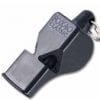 By Bob Currie, Vessel Examiner
By Bob Currie, Vessel Examiner
United States Coast Guard Auxiliary Station Galveston Flotilla.
I was talking to one of my neighbors the other day, and he was telling me about how he and his wife were enjoying their kayaks. I asked if they had and used a personal flotation device (PFD), and he said yeah, we have and wear them. I then asked if they had whistles. What? You have to have a whistle? Well, the actual requirement is to have a sound signal.
The Station Galveston Flotilla of the US Coast Guard Auxiliary operates out of the USCG Station Galveston base on Galveston Island. They provide assistance to the Coast Guard by providing maritime observation patrols in Galveston Bay; by providing recreational boating vessel safety checks; and by working alongside Coast Guard members in maritime accident investigation, small boat training, watch standing, and property administration.
What’s In This Column for Powerboaters and Sailboaters
Although this column is centered on safe paddlecraft operation, the intended audience is all boaters. We all share the water (and the boat ramps, for that matter; yes, paddlecraft pay launch fees too), and we all can benefit from knowing about the safe operation of all types of boats. Many of my powerboat and sailboat friends also own and operate paddlecraft. The reasons and benefits are many: improvement in health from the exercise, reaching fish that can’t be reached by powerboats, and the fellowship that can be found among paddlecraft operators is the best. Don’t forget about economy of operation. Instead of spending $400 for fuel, ice, and bait, you can be on the water for free with a kayak (or maybe just for a launch fee).
Many paddlecraft fishermen use artificial bait (which can be used over and over), but live bait can be used with an aerated bucket or, if you have one of the fancy rigs, a live well in the hull of your kayak. Yes, I am a fisherman, but sometimes I launch my kayak just for the exercise or to see the natural beauty of the marshes. Paddlecraft open up a whole new world on the water. You can hear things that you can never hear running a powerboat. Sailors will attest to that.
Kayaks: The Draw
Kayaking is not just a cheap method of getting on the water, although you can purchase an entry level kayak for just a couple of hundred dollars. Specialized kayaks can cost thousands of dollars, though, and there has been an increase in high end fishing and whitewater kayaking models that can cost as much as a powerboat. So, it’s not just about the cost. It is more about the experience than anything else.
Why We Have a Paddle Craft Vessel Safety Check
The U.S. Coast Guard Paddle Craft Vessel Safety Check (VSC) covers a wide variety of recreational boats that include kayaks, canoes, row boars, paddleboards, and sculls. All safety equipment that is recommended is essential, since paddle craft can swamp or capsize easily and boaters can be injured or drown. Especially important is that paddle craft boaters acquire the knowledge and skills to operate their vessels safely and to use good judgment in deciding whether they can handle the weather and sea conditions that are likely to occur on each trip. As a result, the boater education aspect of the Vessel Safety Check becomes even more important. Below are the VSC requirements.
Sound Signal
Operators of non-motorized boats are required to have some means of making a detectable oral or mechanical sound signal that can be heard from no less than one-half mile away, such as a whistle or a horn.  Ideally it is attached to your life jacket. Although just about any whistle will do, a pea-less whistle is highly recommended. Old style whistles have a ball-shaped piece of cork in them that helps make the whistle loud. That piece of cork deteriorates quickly when it is exposed to water. Newer models such as the Fox40 whistle do not have a pea and are not affected by immersion in water.
Ideally it is attached to your life jacket. Although just about any whistle will do, a pea-less whistle is highly recommended. Old style whistles have a ball-shaped piece of cork in them that helps make the whistle loud. That piece of cork deteriorates quickly when it is exposed to water. Newer models such as the Fox40 whistle do not have a pea and are not affected by immersion in water.
Personal Flotation Device (PFD)
The requirements for a personal flotation device (life jacket) are the same as those for a powerboat or sailboat. There must be one Coast Guard approved PFD, adjusted to the wearer, and immediately available. It is important to wear your PFD at all times when in, on and around the water. This is especially true in the case of small boats or paddlecraft due to the increased chance of capsizing. A canoe or kayak can capsize even in calm waters.
According to the U.S. Coast Guard statistics at least 90% of people who drown in boating accidents were not wearing a PFD at the time. PFDs can save lives, but only when worn. Although not required, it is always a good idea to have a Type IV Throwable Device onboard for use in an emergency situation. All occupants less than 13 years of age must wear a Type I, II, or Type III PFD when not at the dock under Texas regulations.
Overall Vessel Condition
In order to receive the VSC decal, the paddle craft condition must be good overall. The examiner will make sure that the hull and deck are sound. Even a small leak could impact the stability of the vessel. If holes are patched with duct tape, the vessel will not qualify for a vessel safety check decal. If the paddle craft has a skeg or a rudder, it must be working and fastened securely. Hatch covers must be in good condition, secure and fitted properly. Deck lines and bungee cords must be in good condition and secure, not fraying or hanging off the paddle craft. The paddler uses the lines to secure equipment, get back into the paddle craft if he or she has fallen overboard, and hold on to the boat if it has capsized. Bulkheads, airbags, emergency flotation must be in good working order. The examiner will check for holes and cracks.
Some paddle craft do not have any bulkheads and instead require the use of airbags or foam blocks at the stern and bow to help provide flotation. This type of craft will become unusable or will sink when flooded if the airbags or foam blocks are missing. Paddles and oars must be serviceable. They must not have any visible cracks or fractures along the blade or shaft.
Navigation Lights
Although the U.S. Coast Guard only requires that a paddle craft operating between sunset and sunrise or in restricted visibility have a white light, Texas boating regulations state that “canoes, kayaks, and all other manually driven vessels may exhibit sidelights and a stern light, or “when not at dock must have and exhibit at least one bright light, lantern, or flashlight visible all around the horizon from sunset to sunrise in all weather and during restricted visibility.”
Visual Distress Signals (VDS)
If operating between sunset and sunrise, a VDS suitable for night use must be carried when operating in coastal waters (water that lies within 9 nautical miles from the coastline of Texas). Galveston East Bay is considered to be coastal waters. You must have either one (1) Coast Guard approved electric light (with S.O.S.) or three (3) combination day/night flares. Expired signals do not meet the requirement and are unreliable if used.
State and/or Local Requirements
In order to receive a VSC decal, the paddle craft must meet state and local requirements as well. I have noted such requirements above, but it is best to read and familiarize yourself with the rules rather than rely on this article. The best way to do that is to use your Coast Guard app that you have hopefully loaded onto your smart phone. It has all of the requirements for each state.

Free Paddle Sports Safety Course
I highly recommend that all paddle craft operators take a paddle craft course. Here is a link to an online course that one may take and receive certification:
https://www.boaterexam.com/paddling/
Summary
Knowing the Coast Guard requirements for operating a paddle craft can make kayaking, canoeing, and Stand Up Paddleboard operation safer for the operator and those operating other forms of vessels.
For more information on boating safety, please visit the Official Website of the U.S. Coast Guard’s Boating Safety Division at www.uscgboating.org. Questions about the US Coast Guard Auxiliary or our free Vessel Safety Check program may be directed to me at [email protected]. I am available to perform free Vessel Safety Checks, and I will come to your location to perform them. SAFE BOATING!
[8-12-2019]

 Posted in
Posted in 
























